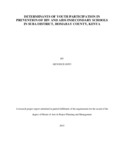| dc.description.abstract | Knowledge, attitudes and sexual behavior change towards HIV/AIDS remains a primary goal of
HIV prevention efforts.HIV and AIDS is one of the leading health problems in Kenya where
nearly 7.1% of the population had been infected by the disease in 2011. Suba District in
Homabay County is having the highest (26%) prevalence of HIV. Thus, the purpose of this study
was to determine the factors that influence the participation of the youth in prevention of HIV/
AIDS in Suba District. The objective of the study was to assess how the knowledge on HIV/
AIDS, social conditions, attitudes and the sexual behaviors of secondary school students
influence their participation in the prevention of HIV/ AIDS. The literature reviewed indicated
that the knowledge or information that high school students have about HIV and AIDS is not
accurate since they still have misconceptions about the diseases. Students engage in sex from the
age of 11 years. This exposes them to the risk of acquiring HIV due to the inaccurate knowledge
that they have about prevention of the disease. Social conditions such as poverty also prevent
students from accessing VCTs and condoms, which they require to prevent the spread of the
disease. Negative attitudes towards people living with HIV and AIDS hinder prevention of the
disease by encouraging stigmatization. The study used a descriptive research design. The target
population was students in rural secondary schools in Suba District. The data was collected from
a sample of 371 students who were selected through a stratified sampling technique. The data
was collected usingquestionnaires with structured and unstructured questions. Data analysis was
conducted through descriptive statistics. The study found that 100% of the students had heard
about HIV and AIDS. At least 80% of the students were aware of the major modes of HIV
transmission, which include unprotected sex, sharing sharp objects, and blood transfusion. The
study found that 44.7% of the students strongly agreed that if a member of their family was HIV
positive, the information should remain secret. Moreover, 63.1% of the students strongly agreed
that condom use education should be introduced in their schools. The study found that 63.1% of
the students had had sex at least once in their lifetime and 56% of them used a condom in their
last sexual intercourse. Moreover, 81.1% of the students had gone for HIV tests. 53.8% of the
students stated that having unprotected sex was the main adverse social condition that exposed
them to the risk of acquiring HIV. In addition, 27.1% were likely to acquire HIV/AIDS because
of risky leisure activities such as drinking alcohol. The study concluded that the students lack
accurate information/ knowledge on HIV/ AIDS. The quality of information about the disease
among students should be improved to prevent the spread of the disease. Students’ sexual
behaviors and social conditions also expose them to the risk of acquiring HIV/ AIDS. Thus,
students should be encouraged to use condoms and refrain from risky leisure activities such as
drug abuse. The government in collaboration with the community should address the stigma
associated with HIV and AIDS to enhance its prevention. | en_US |

